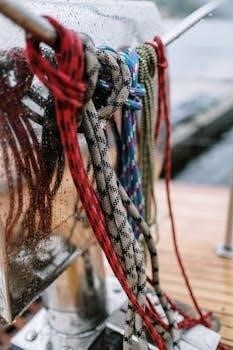
Printable Knot Tying Guide PDF⁚ An Overview
Looking to master the art of knot tying? A printable knot tying guide PDF is an invaluable resource. These guides offer clear diagrams and instructions for various knots, perfect for beginners and experienced users alike.

Basic Knots for Beginners
Embark on your knot-tying journey with essential knots for beginners. These include the figure-eight knot, reef knot, bowline, sheet bend, and clove hitch; Mastering these foundational knots will build a strong base for more advanced techniques.
Figure-Eight Knot
The figure-eight knot is a fundamental and easily recognizable knot, primarily used as a stopper knot. Its main purpose is to prevent a rope from slipping through a hole or a device. This knot is favored due to its simplicity, reliability, and the fact that it doesn’t weaken the rope as much as some other stopper knots.
To tie a figure-eight knot, start by forming a loop near the end of the rope. Then, bring the end of the rope over and around the standing part of the rope. Finally, pass the end back through the loop you initially created. Tighten the knot carefully to ensure it’s formed correctly, resembling the number eight.
The figure-eight knot is widely used in various applications, including climbing, sailing, and general rope work. Its ease of tying and untying, even after being heavily loaded, makes it a popular choice for securing ropes and preventing them from unraveling. This knot is a must-know for any beginner venturing into knot tying.
Reef Knot (Square Knot)
The reef knot, also known as the square knot, is a simple binding knot used to secure two ropes of similar diameter together. It’s commonly employed for tasks like tying bandages or packages. However, it’s crucial to understand its limitations. The reef knot is not reliable for critical applications where safety is paramount, as it can easily come undone if not tied correctly or if the ropes are of different sizes.
To tie a reef knot, start by holding one end of each rope in each hand. Cross the right end over the left end and tie a simple overhand knot. Then, cross the same ends again, right over left, and tie another overhand knot. Ensure that the knot is dressed neatly by pulling on all four ends to tighten it evenly.
Despite its simplicity, the reef knot can be dangerous if misused. It’s essential to recognize that it’s not a substitute for more secure knots in situations where lives or equipment are at risk. Always double-check the knot and consider using alternative knots for critical applications.
Bowline
The bowline is a versatile knot renowned for its ability to create a secure loop that won’t slip or tighten under load. Often referred to as the “King of Knots,” the bowline is a staple in sailing, climbing, and rescue operations. Its reliability and ease of tying make it an essential knot for anyone working with ropes.
To tie a bowline, start by forming a small loop in the standing part of the rope, known as the “rabbit hole.” Bring the working end of the rope, the “rabbit,” up through the hole, around the back of the standing part, and then back down through the hole. Dress the knot by tightening the loop and the standing part.
The bowline is prized for its strength and stability. It’s easy to untie even after being subjected to heavy loads, making it a practical choice for various applications. However, like any knot, it’s crucial to practice and understand its limitations. Always inspect the knot before use and consider using a backup knot for added security in critical situations.
Sheet Bend
The sheet bend is a vital knot for securely joining two ropes of different diameters. Unlike some knots that struggle with varying rope sizes, the sheet bend excels in these situations, providing a reliable connection for a range of applications.
To tie a sheet bend, begin by forming a bight (a U-shaped loop) in the larger of the two ropes. Pass the end of the smaller rope through the bight, around both parts of the larger rope, and then tuck it under itself. Ensure the ends of both ropes finish on the same side of the knot.
This knot is particularly useful in sailing, where different sized ropes are common. It’s also handy in camping and general rope work. A double sheet bend, where the smaller rope is passed twice around the bight of the larger rope, provides even greater security, especially with slippery or significantly different diameter ropes. Always check the knot after tying to ensure it’s properly formed and dressed.
Clove Hitch
The clove hitch is a simple and versatile knot primarily used to fasten a rope to a post, pole, or any cylindrical object. It’s known for its ease of tying and quick adjustability, making it a go-to knot for temporary fixings. However, it’s crucial to understand its limitations, as it can slip or come undone if not properly tightened or if subjected to fluctuating loads.
There are a couple of ways to tie a clove hitch. One method involves forming two loops and slipping them over the post. The other method involves wrapping the rope around the post and then tucking the end under the standing part of the rope, followed by another wrap and tuck.
While convenient, the clove hitch isn’t ideal for situations where a secure, long-term hold is required. It is frequently used in sailing for temporary moorings and in construction for securing scaffolding. It is important to regularly check the knot and consider using a more secure knot if safety is paramount.
Advanced Knot Tying Techniques
Beyond the basic knots lie advanced techniques that offer increased strength, security, and specialized applications. Mastering these techniques requires practice and a deeper understanding of knot mechanics. These advanced knots are often used in climbing, sailing, rescue operations, and other demanding situations where reliability is critical. Learning these knots from a printable guide can be a great first step.
Advanced knot tying often involves variations on basic knots, incorporating multiple wraps, braids, or interlocking structures to enhance their holding power. Some advanced knots are designed for specific purposes, such as creating adjustable loops, joining ropes of different diameters, or forming secure hitches under heavy loads.
A printable guide PDF can provide detailed diagrams and step-by-step instructions for these complex knots. The PDF should include information on the knot’s strengths, weaknesses, and suitable applications. This allows you to expand your knot tying skills and tackle more challenging tasks with confidence. Safety considerations are also paramount when working with advanced techniques.

Knots for Specific Purposes
Different activities require specialized knots. Scouting, fishing, and macrame each utilize unique knot tying techniques. Printable PDF guides cater to these specific needs, offering relevant knot instructions.
Scouting Knots
Scouting relies heavily on practical knot tying skills for various outdoor activities and survival situations. A printable knot tying guide PDF can be an essential tool for scouts of all levels, from beginners to experienced outdoorsmen. These guides often feature knots specifically chosen for their utility in camping, hiking, and pioneering scenarios.
Common scouting knots include the square knot (reef knot) for joining ropes of similar size, the bowline for creating a secure loop, and the sheet bend for joining ropes of different sizes. The clove hitch is useful for attaching a rope to a pole or stake, while the figure-eight knot serves as a stopper to prevent a rope from fraying or slipping through a hole.
Many printable guides also include information on lashings, which are used to bind poles together to create structures like shelters or bridges. Learning these knots and lashings is a fundamental part of scouting and can greatly enhance a scout’s ability to navigate and thrive in the wilderness. Access to a clear and concise PDF guide ensures scouts can easily learn and practice these vital skills.
Fishing Knots
For anglers, the ability to tie strong and reliable knots is crucial for success. A printable knot tying guide PDF tailored for fishing can be an invaluable resource, outlining knots designed specifically for securing lines to hooks, lures, swivels, and other terminal tackle. The right knot can mean the difference between landing a trophy fish and losing it.
Essential fishing knots often featured in these guides include the improved clinch knot for attaching line to a hook or swivel, the Palomar knot known for its exceptional strength, and the uni knot, a versatile knot used for various purposes, including line-to-line connections and attaching hooks. The surgeon’s knot is another common choice for joining two lines together.
Printable guides also often include knots for tying leaders, such as the blood knot or the Albright knot. Clear diagrams and step-by-step instructions make it easy for anglers of all skill levels to learn and master these knots, ensuring they are well-equipped for any fishing situation. A readily accessible PDF guide can be kept in a tackle box for quick reference on the water.
Macrame Knots
Macrame, the art of knotting cords to create decorative textiles, relies on a specific set of knots to form intricate patterns and designs. A printable knot tying guide PDF focused on macrame can be a valuable tool for crafters of all levels, providing clear instructions and visual aids for mastering these essential techniques.
Key macrame knots typically featured in these guides include the square knot, the most fundamental macrame knot, forming the basis for many designs. The half hitch knot, often used in variations to create spirals and patterns, is another essential technique. The lark’s head knot (also known as a cow hitch) is commonly used for attaching cords to a dowel or ring to begin a project.
More advanced knots like the double half hitch and clove hitch may also be included, allowing for more complex and textured designs. A printable guide makes it easy to learn and practice these knots, with step-by-step diagrams and written instructions ensuring clarity and accuracy. Having a readily accessible PDF allows crafters to reference the knots while working on their projects.

Resources for Knot Tying
Numerous resources exist to help you learn knot tying. These include online PDF guides offering visual aids, comprehensive knot tying books, and even interactive apps for practicing different knots.
Online PDF Guides
The internet is a treasure trove of free resources for learning how to tie knots. Among these, online PDF guides stand out as exceptionally useful tools. These guides often present a visual and easily accessible way to learn various knots. You can search for “knot guide pdf” to discover numerous options.
Many PDFs offer step-by-step diagrams and clear instructions, making them ideal for beginners. Some guides focus on specific types of knots, such as scouting knots or fishing knots, while others provide a more comprehensive overview. You can find guides dedicated to macrame knots as well.
These guides can be downloaded and printed, making them handy references for when you are out in the field. Some PDFs even include advanced techniques or knots for specific purposes, catering to different skill levels and interests. Ensure the PDF’s quality by searching for zoomable guides.
Knot Tying Books
For a deeper dive into the world of knot tying, knot tying books are an excellent resource. These books provide comprehensive information, detailed illustrations, and often include historical context and practical applications for different knots. They are a great way to learn the theory behind knot tying.
Several popular knot tying books are available, catering to various interests and skill levels. Some books focus on basic knots for beginners, while others delve into advanced techniques and specialized knots for activities like sailing, climbing, or scouting. These books can be valuable resources.
Look for books with clear diagrams and step-by-step instructions to make learning easier. Some books also include information on rope types, knot strength, and safety considerations. Investing in a well-written knot tying book can significantly enhance your knot tying skills.



